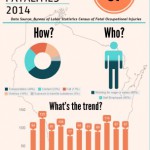 In 2014, there were 97 Wisconsin workers who died due to injury. This number remains unchanged from the final count published in Wisconsin for 2013. The number of workplace deaths in Wisconsin the past decade range from 77 to 125, and average 98 fatalities annually.
In 2014, there were 97 Wisconsin workers who died due to injury. This number remains unchanged from the final count published in Wisconsin for 2013. The number of workplace deaths in Wisconsin the past decade range from 77 to 125, and average 98 fatalities annually.
The preliminary count of occupational fatalities in the U.S. in 2014 is 4,679, a 2% increase from the revised total of 4,585 in 2013.
The Census of Fatal Occupational Injuries is conducted annually nationwide by the U.S. Bureau of Labor Statistics (BLS), and compiles a count of all work-related deaths.
Key findings for Wisconsin in 2014:
- Falls decreased by nearly half, while contact events increased 47%.
- Self-employed workers sustained 39 fatalities, a 44% increase from 2013.
- Employees age 65 and older sustained highest number of fatalities.
- Transportation incidents caused the most fatalities.
- Public sector fatalities decreased by half.
Worker Characteristics and Occupation
Of the 97 fatalities, 12 were in contractor status at the time of their death, which is an increase from 7 in 2013. Self-employed workers sustained 39 fatalities, a 44% increase from 2013.
The highest number of fatal work injuries occurred among age group 65 years and older with 25 deaths, followed by age 45 to 54 with 21, and age 55 to 64 with 19. These same age groups saw an increase in fatalities nationwide. Most fatal work incidents in Wisconsin occurred in the month of August.
Wisconsin transportation and material moving occupations sustained the greatest number of fatal injuries in 2014 at 22 incidents, followed by management occupations with 16 deaths. Construction and extraction occupations sustained 15 fatalities, and 14 deaths occurred among farming, fishing, and forestry workers.
Event
Transportation incidents comprised the highest number of fatal work injuries at 38, followed by contact with objects and equipment with 22, falls, slips, and trips with 16, and violence due to persons or animals with 15. Falls, slips, and trips declined 47% from 2013 while fatal contact injuries increased 47% from 15 to 22. Violent events increased from 11 in 2013 to 15 in 2014. Homicides declined by half from 2013, while suicides increased from 3 to 9 in 2014. Nationally, transportation incidents accounted for 40% of total fatal injuries, followed by falls (17%), violence (16%), and contact injuries (15%).
Industry
In 2014, 92 of the 97 work-related deaths in Wisconsin occurred within private industry. Public sector worker deaths decreased by more than half from the prior year. Agriculture, fishing, forestry, and hunting saw a 30% increase in fatalities from 2013 with 26. Fatalities in the professional and business services industry nearly tripled from 2013 to 2014, while the trade, transportation, and utilities decreased to 17. Fatalities in the construction industry increased slightly to 13. Manufacturing industry deaths rose slightly from 9 in 2013 to 11. Nationally, fatal injuries increased in agriculture, mining, manufacturing, and construction industries.
Background of Census of Fatal Occupational Injuries
The Census of Fatal Occupational Injuries, part of the BLS occupational safety and health statistics program, compiles a count of all fatal work injuries occurring in the United States during the calendar year. The program uses diverse state, federal, and independent data sources to identify, verify, and describe fatal work injuries. For more about the Census of Fatal Occupational Injuries, go to www.bls.gov/iif.
The Wisconsin State Laboratory of Hygiene (WSLH), a part of the University of Wisconsin-Madison, is the state’s public, environmental and occupational health laboratory. The WSLH’s Bureau of Labor Statistics/Occupational Safety and Health Statistics Program has a cooperative agreement with the U.S. Bureau of Labor Statistics to conduct the Census of Fatal Occupational Injuries in Wisconsin.
For more about occupational fatalities in Wisconsin, go to: www.slh.wisc.edu/bls.
